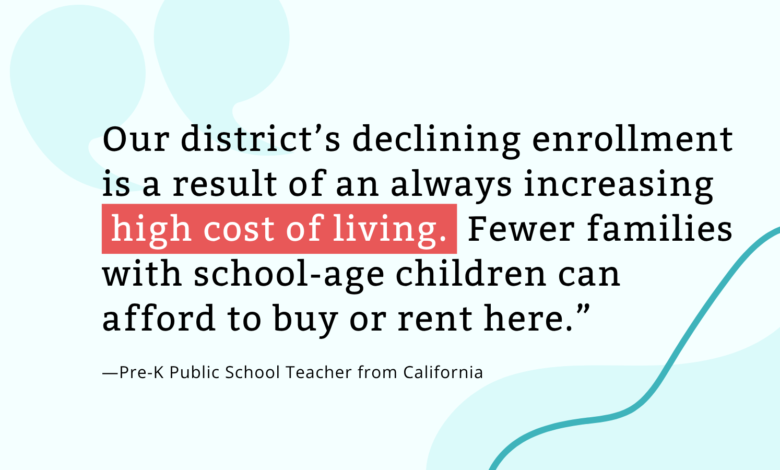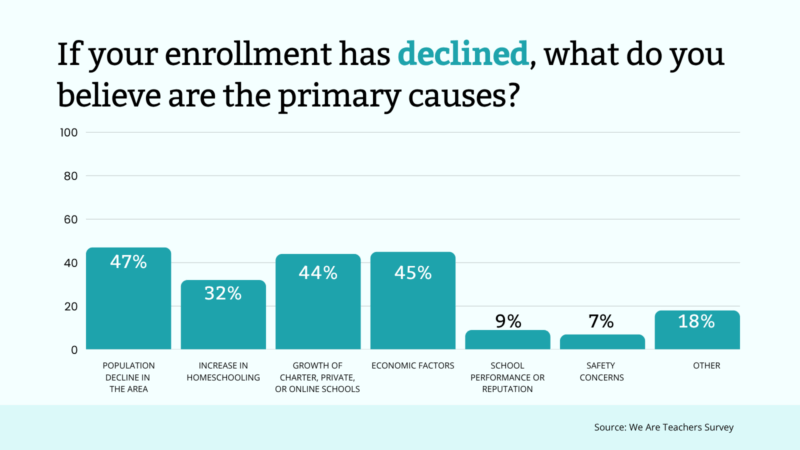What’s Going On With School Enrollment? Educators Weigh In

Is enrollment up or down in your district? The answer might depend on who you ask—and what neighborhood you’re in.
To better understand the changes happening in schools across the country, We Are Teachers surveyed more than 500 educators in all 50 states, including classroom teachers, school leaders, and support staff. From booming elementary classrooms to schools trying to hold steady amid declining population, the data tells a story that many educators already know: Enrollment shifts are real, and the impact is personal.
Here’s what the survey revealed about what’s happening, why it’s happening, and what schools are (or aren’t) doing about it.
Who took the school enrollment survey?
A full 83% of respondents were classroom teachers, offering firsthand insight from the front lines of education. Most teach in public schools (83%), with the majority in elementary grades (55%), followed by middle school (28%) and high school (26%) educators. And these aren’t new teachers either—about 9 in 10 have been in education for 11 years or more. In other words, they’ve seen some things—and they know what they’re talking about.
**note: percentages may not equal 100% since some respondents teach in more than one school.
What’s happening with school enrollment?
Overall, school enrollment numbers are growing, remaining stable, or declining, depending on the location.

- 37% of schools have seen enrollment grow, while 28% have experienced a decline.
- 30% say enrollment has stayed the same, and 5% weren’t sure.
- These shifts are happening quickly: Most growth or decline occurred in the past 3 to 5 years.
We’ve had classrooms filled to the brim. I feel like we are not serving our students well when our attention is so divided.
—Middle School Public Teacher from Maine
What do educators say are the reasons for increased school enrollment in their districts?

Among schools seeing more students:
- 67% cite population growth in the area.
- 49% credit their school’s reputation or performance.
- 35% point to economic factors, such as families relocating for job opportunities.
But growth isn’t always a win. While student numbers may be rising, the resources to support them often aren’t. Seventy-five percent of schools experiencing enrollment growth say they’re feeling the pressure to accommodate more students—without the tools to do it well. Only 21% of those schools reported a budget increase, and just 19% were able to add new programs to help meet the needs of their expanding population. For many educators, it feels like trying to stretch the same resources across more and more desks.
What do educators say are the reasons for decreased school enrollment in their districts?

Among schools losing students:
- 47% cite population decline.
- 44% say families are leaving for private, charter, or online schools.
- 44% point to economic shifts, like rising housing costs.
- Only 9% blamed the school’s reputation—challenging a common assumption.
The consequences are immediate—and tough to ignore. Nearly three-quarters (72%) of schools with declining enrollment have reduced staff, often losing experienced educators and support roles that are hard to replace. Budget cuts have followed for 62% of schools, forcing leaders to make difficult choices about what to prioritize. And for about a third of these schools, program cuts have become a reality, from enrichment opportunities to electives. In response, many are now shifting energy toward recruitment efforts, trying to bring families back through open houses, social media, and word of mouth.
Our district’s declining enrollment is a result of an always increasing high cost of living. Fewer families with school-age children can afford to buy or rent here.
—Pre-K Public School Teacher from California
How schools are responding (or not) to school enrollment changes:
Just under half of educators (47%) say their school or district has taken steps to respond to changing enrollment, but a surprising 33% are unsure if any action has been taken. That uncertainty highlights a larger issue: a lack of clear communication and transparency regarding how schools are planning for the future.
Among those who are seeing action, the most common strategies include:
- Marketing and outreach efforts to boost visibility and attract families (51%)
- Expanding program offerings to meet more student needs (41%)
- Partnering with community organizations for resources and support (42%)
- Hiring new teachers to accommodate growth or backfill vacancies (40%)
But not all changes are additive—22% reported staff reductions, and 15% say their school has undergone consolidations or closures in response to enrollment trends.
I wish admin could think of long-term instead of quick-fix solutions. Families are slowly growing—closing schools too fast can hurt communities more than it helps.
—Elementary Public School Teacher from Pennsylvania
What are educators saying about the effects of school enrollment changes?
We conducted a qualitative thematic analysis on the survey-takers’ open-ended responses. They revealed five big themes:
- More students, fewer supports: Teachers in growing schools say the pressure is real. Class sizes are up, support staff are stretched, and physical space is limited. “We don’t have enough desks, supplies, or rooms. But we keep adding students,” says one public high school teacher in Texas.
- Budget cuts hit staffing first: Declining schools feel the squeeze most in staffing and programming. Teachers report being asked to do more with less—and watching programs they love get cut. “When enrollment dropped, we lost a reading specialist, an art teacher, and three paras,” says an elementary public school teacher in Wisconsin.
- Student behavior is a flashpoint: Across the board, teachers say behavior and discipline challenges are increasing—and often not being addressed. Some tied this directly to enrollment shifts and increases in class size. Whether enrollment is growing, leading to overcrowded classrooms, or declining, resulting in the loss of key support roles such as counselors and behavior specialists, these shifts can destabilize the systems schools rely on to support student behavior. “We need admin support. Back us up on classroom management and stop undermining teacher authority,” a public high school teacher in Texas commented.
- Teachers feel left out of the conversation: Educators want a seat at the table when big decisions are made. They see the issues clearly but often feel shut out of district planning. “Teachers are always the last to know. We hear rumors before we hear plans,” a public high school teacher in North Carolina said.
- Community trust and connection matter: Many say the best way to stabilize enrollment is by building real relationships with families, neighborhoods, and each other. “Take care of your teachers. Happy teachers make a school that families want to be a part of,” says a pre-K private school teacher in Kentucky.
Whether enrollment is rising or falling, the message from educators is clear: It affects everything.
Schools that are growing need more support—more staff, more funding, more space. Schools that are shrinking need protection—against hasty cuts that make recovery harder. But in both cases, teachers want to be heard. They want leadership that communicates, plans strategically, and invests in relationships—both inside and outside the building. Because at the end of the day, as one teacher put it:
You can’t stabilize enrollment without stabilizing the people inside the school first.
—Pre-K Public School Teacher in Kansas
Our friends at Staples Business want you to know that they understand how hard it is to make your school budget meet your school needs. That’s why they promise:
- All the right products, one supplier. Streamline your ordering process across multiple categories, including facilities, technology, furniture, print services, and more.
- Save 20% on school supplies vs. a major competitor. Find all the brands that teachers and parents trust.
- Next-day delivery to over 98% of the United States. Rely on arrival during school hours, and schedule deliveries up to 150 days out.
- 100% satisfaction guaranteed. Outfit your school with trusted quality and everyday value from our Staples family of brands.
- Experts are always ready to help. Get strategic guidance, K-12 product recommendations, cost-saving insights, and more.
- Red tape eliminated. Count on our publicly solicited and awarded contracts with the top cooperative.
You have everything to gain—find out more at Staples Business.
Source link




